
Wine Culture and Information since 2002 - Volume 22
 Wine Culture and Information since 2002 - Volume 22 |
|
Issue 133, October 2014 |
Contents |
|
|
Mala Tempora Currunt |
|
This month I would like to mention Marcus Tullius Cicero - a famous politician and philosopher of Ancient Rome - and one of his most famous quotes. For the sake of truth, the quote is Mala tempora currunt sed peiora parantur, that is “bad times are upon us but the worst has yet to come”. I wanted to omit the final part in order to be wisely optimistic while trusting - of course - the future will not however be that bad. Or, at least, this is what I want to wish us, because - I am sure of this - things will not be that bad for everyone. As we are talking about wine which, commercially speaking, in recent times it is not having a good fate as there are many wineries having a huge number of bottles still unsold and which will be forced to put them on sale, I guess it is better to think positive. Only for this reason, “bad times are upon us” and this is true for producers for sure who do not certainly need new accidents for which it is required to find a solution. On this regard, it is wished they could use this time for making better grapes and wines. The title is referred to the meteorological conditions of 2014 which in Italy have certainly not helped the fate of grapes in vineyards. Rain, heavy rains, a summer very rich in water, something not happening since a lot of years. Such an atypical season has been cause of many troubles, not only for the ones making wine and cultivate vines, but - generally speaking - to all the food and agriculture production. By traveling in Italy, it was not so difficult - this year - to see vineyards heavily damaged by the effects of downy mildew and powdery mildew, as well as devastated fields of wheat, fruits and olives in remarkable delay of ripeness: the situation is considered at risk for many. Heavy rains and the lack of sunshine, have caused a significant delay in fruit ripeness - including grape - and it is believed harvesting will be postponed of about two weeks. Fifteen days may be considered “not so much”, indeed they represent a remarkable risk. 2014 will therefore be a bad vintage, enologically speaking? Of course, no. Not only for the fact wines of this vintage do not exist yet - therefore it would make no sense to say anything about them - as well as for the fact not all the Italian regions had this particularly bad season. As fall is coming - and, maybe, by watching what we had in summer, it arrived with many weeks in advance - things in vineyards of certain regions could get even worse. Grape needs to complete its ripeness cycle, however without sunshine this process is pretty difficult. Moreover, the chance of rains will increase - and a lot - the risk of mold. A “plague” which would cause further damages and added to those already caused by downy mildew and powdery mildew, with the result of compromising harvesting even more. Harvesting that, it is very likely, could give grapes with pretty modest quantity of sugar, therefore making wines with low quantity of alcohol and a pretty high crispness. This is related, of course, to sound grapes which will be possible to harvest. In this not properly positive scenario, many producers have however said the grape they will be successful in “saving” is of good quality. There are producers - like to say - who have raised a white flag already, on the contrary, others are even happy for what they harvested in their vineyards, such us Sicilian vintners. There are some who will not be successful in harvesting any grape bunch and others who have said there will not be any 2014 vintage for what they consider to be their best wines or however the most significant ones. This could be considered as an act of honesty and respect towards their clients and - indeed - it is, also in order to safeguard their good name and the quality of certain wines. The ones who will not be successful in harvesting significant grapes - both in quality and quantity terms - will certainly have to find a good solution in order to not compromise the profit for 2014. The easiest solution is to buy grapes from the ones who have some of “acceptable quality” and wish to sell it. Not to mention, it is not so difficult to understand there will be a sort of speculation of prices because of the high demand. Mors tua, vita mea. (Your death, my life) On the other hand, the lower temperature - that in certain areas of Italy has never been significantly high - will let grapes to keep certain aromatic characteristics. We will therefore have less alcoholic wines, however more acidic and with good aromas. Like to say, every cloud has a silver lining or, better to say, it is always wise to be happy with what you get. In case we want to be “bad”, we could also say the lack of sugar in grapes can be corrected by adding concentrated must and the excessive acidity can be lowered by simply using legal and licit methods. However, it should be noticed these methods are not used in bad vintages only: they simply represent some possibilities they have in order to correct a wine when needed. In some countries, for example, the lack of sugar can be corrected - and legally - by adding sucrose, the common “table sugar”, something being notoriously forbidden in Italy. The situation must not however be considered “tragic”, nevertheless, let's wait until 2014 wines will be poured in glasses before shedding useless tears. Preliminary figures say in Italy we will have a decrease in grape harvesting of about 15%. As a matter of fact, it was since 1950 we did not have such a poor harvesting in Italy and this will yield - according to figures - a production of about 41 millions hectoliters of wine. For the ones loving the endless, although useless, challenge Italy versus France, our country will lose the first rank in the world about wine production and will pass that to France, where it is believed wine production will be of 47 millions hectoliters. Mala tempora currunt: the ones loving this challenge will be sorry to hear that. Central Italy seems to be the only area in Italy where things seems to be better and, they say, it will be even capable of increasing harvesting of 10% more than 2013. No matter how things will be, it will be a successful harvesting, nevertheless for the fact vintners of our country - despite the heavy rains, hails and bad weather - will be capable of giving us great wines. I am sure of this and Marcus Tullius Cicero will not be sorry if I dared to change his quote: mala tempora currunt sed meliora parantur. Bad times are upon us but the best has yet to come. At least in wineries and in glasses: time - I am sure about this - will give us remarkable satisfactions even in this bizarre 2014. Ad maiora! (Towards greater things!) Antonello Biancalana
|
||||
Monovarietal WinesThe study of monovarietal wines is very important in order to understand the expressive qualities of grapes in function of territory and wine making techniques |
|
Sensorial and critical tasting of wine is a practice requiring commitment, concentration, attention and - last but not the least - passion and curiosity. In such a vast wine scene, made of hundreds of different grapes leading - unavoidably - to the production of a virtually endless quantity of different wines, understanding their characteristics is very important. A condition which can also become even more difficult because of the huge quantity of grapes used for the production of wines in the world: only in Italy can be counted about five hundred different varieties. Many of them, of course, have a modest wine making use and, in many cases, even unique, however each of them has a proper wine making dignity and, as such, it is worth to be considered. The most common varieties increase - as a matter of fact - both difficulty and possibility of study. Sensorial tasting of monovarietal wines - that is the ones produced with just one variety - has a high educational value for every taster. The study of these particular wines, despite this can be seen as simple and easy, offers extremely broad and virtually endless conditions of analysis. The tasting of monovarietal wines - in order to understand their characteristics - cannot be done by just evaluating one sample or bottle. Like it is commonly known, and this certainly is one of the many interesting aspects of wine making and viticulture, a variety can have different and significant interpretations in function of environmental, cultural and enological conditions. To this we can also add the variable factors added by each vintage: the results become virtually endless. The peculiar characteristics of each variety can in fact change - even drastically - in function of these factors, although remaining, in certain aspects, fully recognizable. In other words, wines produced from Pinot Noir in Burgundy can be pretty different from those produced in Oregon, despite many of the typical characteristics of this variety will be recognizable in both cases. The same is true for every other variety: the specific characteristics of each grape will however be recognizable no matter of viticultural, environmental and enological conditions and factors. Another significant example is given by Merlot. Its renowned roundness, capable of giving wines an unmistakable smoothness, can be perceived also in wines produced in conditions, places and vintage being so different one from each other. The study of monovarietal wines is also fundamental for understanding the vast category of multivarietal wines, produced by using many varieties and according to specific wine making techniques. Knowing how to recognize the peculiar characteristics of each grape is therefore fundamental for the understanding and the evaluation of these wines, playing a very important role in the wine making scene. On this regard it should be noticed what it is considered by many a sort of magic attitude in which someone can tell a wine, area and vintage by simply watching the color or smelling the glass. This is of course possible, however it is something mainly associated to common belief instead to reality. It is not however a supernatural quality, indeed, it is the result of years spent in tasting wines and in a very strict and analytical way. Superficiality, it should not be forgotten, does not get along with analytical and sensorial tasting.
There are varieties, in their evident and immediate character, being easier to recognize even after having tasted their wines for few times. On the contrary, there are varieties being more difficult to understand and less expressive: the skill required to recognize them takes a long time and practice: in certain cases, the risk of being mistaken with another grape is pretty high. It is about a study journey to be done step by step and, as such, it is best to begin by tasting varieties having unmistakable qualities. On this regard, it is good to taste all of aromatic varieties, that is the grapes which wines have a clear and evident aroma of grape. Because of the low number of grapes belonging to this category, their study is simple and very effective. Aromatic varieties, for the sake of clearness, are Muscat Blanc, Gewürztraminer and Brachetto. Let's begin this type of study and, to do so, we will compare three wines produced with these grapes, belonging to the same vintage and vinified as dry. This is a fundamental aspect, as Muscat Blanc and Brachetto are frequently vinified as sparkling, in particular in Italy. It is not required the three wines to be from the same territory or country: in this case we are interested in studying the aromatic characteristic of these grapes and their wines. This does not mean all the wines produced with these grapes have the same organoleptic qualities. With time we will understand also these grapes - having a strong and intense character - can have remarkable differences in function of the territory and vintage. In the beginning it will be enough to understand the peculiar characteristics of each of them by comparing the three wines one to each other in order to understand their analogies and differences. We can start from simple things while considering the huge variability of aromatic grapes in function of the many viticultural and wine making factors. The next step we can do - after having made friends with the three aromatic varieties - is to focus our study on just one of them. In order not to introduce disturbing elements which could excessively affect the result of the evaluation, in the beginning it is better to avoid wines produced with particular wine making techniques, such as the use of cask and barrique. These elements in fact give wines organoleptic characteristics which can change - sometimes even drastically - the specific qualities of grapes. It is better to pay attention on territorial and viticultural differences, last but not the least, wines produced in different vintages as well. The important thing is that wines are produced with inert containers, such as steel or cement. We may consider, for example, Gewürztraminer wines produced in three different areas, such as South Tyrol, Rhine Valley and Alsace. In case we want to broad our possibilities of study, we may also add Gewürztraminer wines produced in Sicily and Australia, in order to have a better idea offered by different territories. The fundamental factor is that wines must be produced in inert containers and possibly belonging to the same vintage or however in vintages of adjacent years. Wines produced with the same variety and coming from different areas, let us understand the influence of climate and how the heat and cold affect not only aromas but also body. The same consideration can be done for vintage, its meteorological condition and the period of harvesting. A method of study that, it should be noticed, is valid for every variety, despite studying aromatic grapes certainly is easier than non aromatic grapes. By practicing and with time, we can increase the difficulty by studying monovarietal wines produced in wood containers, such as cask and barrique. At this point we should be able to recognize the main characteristics of the varieties we are studying and we can therefore try to spot their organoleptic qualities by isolating the contribution of wood. This exercise can be considered simple, as one can think the recognition of the organoleptic qualities of wood are evident and obvious, therefore easily recognizable. Indeed, despite in certain cases the influence of wood is excessive, therefore dominant, time and responsible use of cask may introduce light and harmonic organoleptic characteristics, in a way to pass completely unnoticed to the superficial taster. By continuing the study of monovarietal wines, another interesting exercise is represented by the evaluation of four samples - produced by the same winery and in the same area - having different wine making characteristics. For example, we could examine four bottles made from the same variety of which one being young and vinified in inert container, another one being young and aged in wood, then the same wines aged for some years in bottle. This exercise offers the possibility of understanding how a variety can evolve with time and in function of how it was vinified, while considering, in any case, the peculiar and specific characteristics of their respective vintages. In theory, the exercise should be done for every territory in which the variety being studied is significantly cultivated, while taking into account the peculiar characteristic of the variety will always be found according to the interpretation of vintage and grape. By considering what has been said so far, it is clear case studies are countless and, as such, it is not simple - although not impossible - to remember everything and to treasure our tasting experience. On this regard it is useful to make use of that trick every taster should never stop using: writing down his or her own impressions and to take note. A simple and effective method, our notes will be always useful whenever we are about to taste a wine produced with the varieties of which we have written down our personal and sensorial impressions. In order to quickly retrieve our past tasting experiences when we need them, it certainly is good to catalog and order them in a functional and practical way. The study of monovarietal wine is not a practice reserved to beginners only. This type of study, in all of its countless variables, follows - like to say - the life of every taster. Not only a fundamental exercise for the understanding of each variety in function of the territory and the many productive factors, but also a useful practice for improving our skills and training. Moreover, tasting monovarietal wines is fundamental for the understanding and study of the ones called multivarietal, that is produced by blending different grapes. Knowing each variety and its wine making expression will in fact be useful for recognizing them in those wines in which they are used with other grapes. After all, it is not possible to recognize a grape or territory in case you do not know it or you never tasted it. Recognizing a variety among many others is a remarkable satisfaction, the right reward for the time spent in this type of study.
|
||||||||||||
Wines of the Month |
|
|
|
Score legend Prices are to be considered as indicative. Prices may vary according to the country or the shop where wines are bought |
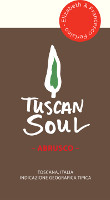
|
|
Tuscan Soul Abrusco 2011 |
|
| Ferlaino (Tuscany, Italy) | |
 Abrusco Abrusco | |
| Price: € 22.00 | Score: |
 Deep ruby red color and nuances of ruby red, impenetrable to light. Deep ruby red color and nuances of ruby red, impenetrable to light. Intense, clean, pleasing and refined aromas, starts with hints of black cherry,
blackberry and blueberry followed by aromas of plum, violet, vanilla, tobacco, pink
pepper and mace. Intense, clean, pleasing and refined aromas, starts with hints of black cherry,
blackberry and blueberry followed by aromas of plum, violet, vanilla, tobacco, pink
pepper and mace.
 Good correspondence to the nose, tannic attack and however balanced by
alcohol, good body, intense flavors, pleasing roundness. Good correspondence to the nose, tannic attack and however balanced by
alcohol, good body, intense flavors, pleasing roundness.
 Persistent finish with flavors of black cherry, blackberry and blueberry. Persistent finish with flavors of black cherry, blackberry and blueberry. 18 months in barrique, 8 months in bottle. 18 months in barrique, 8 months in bottle. |
|
 Roasted meat, Broiled meat and barbecue, Stewed meat, Hard cheese Roasted meat, Broiled meat and barbecue, Stewed meat, Hard cheese |
|
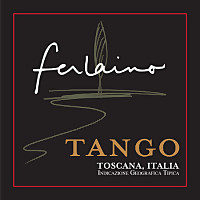
|
|
Tango 2010 |
|
| Ferlaino (Tuscany, Italy) | |
 Merlot (58%), Cabernet Franc (25%), Petit Verdot (10%), Teroldego (7%) Merlot (58%), Cabernet Franc (25%), Petit Verdot (10%), Teroldego (7%) | |
| Price: € 30.00 | Score: |
 Intense ruby red and nuances of garnet red, little transparency. Intense ruby red and nuances of garnet red, little transparency. Intense, clean, pleasing and refined, starts with hints of black
currant, black cherry and plum followed by aromas of violet, vanilla,
blueberry, tobacco, chocolate, mace and eucalyptus. Intense, clean, pleasing and refined, starts with hints of black
currant, black cherry and plum followed by aromas of violet, vanilla,
blueberry, tobacco, chocolate, mace and eucalyptus.
 Properly tannic attack and however balanced by alcohol, good body,
intense flavors, pleasing roundness. Properly tannic attack and however balanced by alcohol, good body,
intense flavors, pleasing roundness.
 Persistent finish with flavors of black currant, black cherry and plum. Persistent finish with flavors of black currant, black cherry and plum. 18 months in barrique, 8 months in steel tanks, at least 8 months in
bottle. 18 months in barrique, 8 months in steel tanks, at least 8 months in
bottle.
|
|
 Roasted meat, Stewed and braised meat, Hard cheese Roasted meat, Stewed and braised meat, Hard cheese |
|
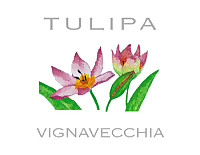
|
|
Tulipa 2013 |
|
| Fattoria Vignavecchia (Tuscany, Italy) | |
 Sangiovese Sangiovese | |
| Price: € 10.00 | Score: |
 Intense pale pink color and nuances of pale pink, transparent. Intense pale pink color and nuances of pale pink, transparent. Intense, clean and pleasing aromas, starts with hints of cherry, plum
and blackberry followed by aromas of raspberry, strawberry and cyclamen. Intense, clean and pleasing aromas, starts with hints of cherry, plum
and blackberry followed by aromas of raspberry, strawberry and cyclamen.
 Good correspondence to the nose, crisp attack and however balanced
by alcohol, good body, intense flavors. Good correspondence to the nose, crisp attack and however balanced
by alcohol, good body, intense flavors.
 Persistent finish with flavors of cherry, raspberry and plum. Persistent finish with flavors of cherry, raspberry and plum. 6 months in steel tanks, 2 in bottle. 6 months in steel tanks, 2 in bottle. |
|
 Meat appetizers, Pasta with fish, Roasted fish, Dairy products Meat appetizers, Pasta with fish, Roasted fish, Dairy products |
|
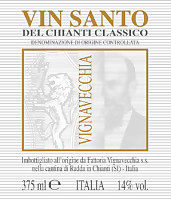
|
|
Vin Santo del Chianti Classico 2006 |
|
| Fattoria Vignavecchia (Tuscany, Italy) | |
 Malvasia Bianca Malvasia Bianca | |
| Price: € 17.00 - 375ml | Score: |
 Deep amber yellow color and nuances of amber yellow, moderate
transparency. Deep amber yellow color and nuances of amber yellow, moderate
transparency.
 Intense, clean, pleasing, refined and elegant, starts with hints of
raisin, dried fig and caramel followed by aromas of almond, date, honey,
vanilla, lavender, walnut, citrus fruit peel, tobaco and nail polish. Intense, clean, pleasing, refined and elegant, starts with hints of
raisin, dried fig and caramel followed by aromas of almond, date, honey,
vanilla, lavender, walnut, citrus fruit peel, tobaco and nail polish.
 Sweet and round attack, however balanced by alcohol, full body, intense
flavors, pleasing crispness. Sweet and round attack, however balanced by alcohol, full body, intense
flavors, pleasing crispness.
 Persistent finish with flavors of raisin, dried fig and date. Persistent finish with flavors of raisin, dried fig and date. 5 years in caratelli barrels. 5 years in caratelli barrels. |
|
 Jam and dried fruit tarts, Hard and piquant cheese Jam and dried fruit tarts, Hard and piquant cheese |
|
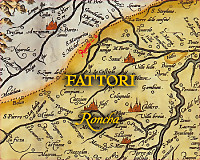
|
|
Roncha 2012 |
|
| Fattori (Veneto, Italy) | |
 Garganega (50%), Pinot Grigio (20%), Trebbiano di Soave (20%), Durella (10%) Garganega (50%), Pinot Grigio (20%), Trebbiano di Soave (20%), Durella (10%) | |
| Price: € 18.00 | Score: |
 Brilliant straw yellow color and nuances of straw yellow, very
transparent. Brilliant straw yellow color and nuances of straw yellow, very
transparent.
 Intense, clean, pleasing and refined, starts with hints of apple, plum
and hawthorn followed by aromas of pear, pineapple, broom, peach, almond
and mineral. Intense, clean, pleasing and refined, starts with hints of apple, plum
and hawthorn followed by aromas of pear, pineapple, broom, peach, almond
and mineral.
 Crisp attack and however balanced by alcohol, good body, intense
flavors, pleasing roundness. Crisp attack and however balanced by alcohol, good body, intense
flavors, pleasing roundness.
 Persistent finish with flavors of apple, peach and plum. Persistent finish with flavors of apple, peach and plum. A small part of Garganega is dried for 5-6 months. Aged in cask and
steel tanks. A small part of Garganega is dried for 5-6 months. Aged in cask and
steel tanks.
|
|
 Stuffed pasta, Broiled fish, Roasted white meat Stuffed pasta, Broiled fish, Roasted white meat |
|
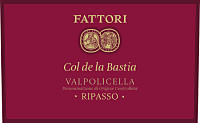
|
|
Valpolicella Ripasso Col de la Bastia 2011 |
|
| Fattori (Veneto, Italy) | |
 Corvina (65%), Corvinone (15%), Rondinella (10%), Altre Uve (10%) Corvina (65%), Corvinone (15%), Rondinella (10%), Altre Uve (10%) | |
| Price: € 28.00 | Score: |
 Intense ruby red color and nuances of garnet red, little transparency. Intense ruby red color and nuances of garnet red, little transparency. Intense, clean, pleasing and refined, starts with hints of blackberry,
plum and black cherry followed by aromas of violet, blueberry, tobacco,
vanilla, chocolate, mace and menthol. Intense, clean, pleasing and refined, starts with hints of blackberry,
plum and black cherry followed by aromas of violet, blueberry, tobacco,
vanilla, chocolate, mace and menthol.
 Good correspondence to the nose, properly tannic attack and however
balanced by alcohol, good body, intense flavors, pleasing roundness. Good correspondence to the nose, properly tannic attack and however
balanced by alcohol, good body, intense flavors, pleasing roundness.
 Persistent finish with flavors of blackberry, plum and black cherry. Persistent finish with flavors of blackberry, plum and black cherry. 18 months in cask. 18 months in cask. |
|
 Roasted meat, Stewed and braised meat with mushrooms, Broiled meat and barbecue Roasted meat, Stewed and braised meat with mushrooms, Broiled meat and barbecue |
|
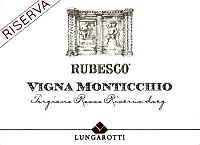
|
|
Torgiano Rosso Riserva Rubesco Vigna Monticchio 2007 |
|
| Lungarotti (Umbria, Italy) | |
 Sangiovese (70%), Canaiolo Nero (30%) Sangiovese (70%), Canaiolo Nero (30%) | |
| Price: € 26.00 | Score: |
 Intense ruby red color and nuances of garnet red, little transparency. Intense ruby red color and nuances of garnet red, little transparency. Intense, clean, pleasing, refined and elegant, starts with hints of
plum, black cherry and dried violet followed by aromas of blueberry,
blackberry, raspberry, vanilla, anise, chocolate, tobacco, pink pepper,
mace, cinnamon and menthol. Intense, clean, pleasing, refined and elegant, starts with hints of
plum, black cherry and dried violet followed by aromas of blueberry,
blackberry, raspberry, vanilla, anise, chocolate, tobacco, pink pepper,
mace, cinnamon and menthol.
 Properly tannic attack and however balanced by alcohol, good body,
intense flavors, pleasing roundness. Properly tannic attack and however balanced by alcohol, good body,
intense flavors, pleasing roundness.
 Very persistent finish with long flavors of plum, black cherry and
blueberry. Very persistent finish with long flavors of plum, black cherry and
blueberry.
 12 months in barrique, 4 years in bottle. 12 months in barrique, 4 years in bottle. |
|
 Game, Roasted meat, Braised and stewed meat, Hard cheese Game, Roasted meat, Braised and stewed meat, Hard cheese |
|

|
|
San Giorgio 2005 |
|
| Lungarotti (Umbria, Italy) | |
 Cabernet Sauvignon (50%), Sangiovese (40%), Canaiolo Nero (10%) Cabernet Sauvignon (50%), Sangiovese (40%), Canaiolo Nero (10%) | |
| Price: € 25.00 | Score: |
 Intense ruby red color and nuances of garnet red, little transparency. Intense ruby red color and nuances of garnet red, little transparency. Intense, clean, pleasing, refined and elegant. starts with hints of
plum, black currant and black cherry followed by aromas of dried violet,
blackberry, blueberry, vanilla, licorice, chocolate, tobacco, leather, mace
and eucalyptus. Intense, clean, pleasing, refined and elegant. starts with hints of
plum, black currant and black cherry followed by aromas of dried violet,
blackberry, blueberry, vanilla, licorice, chocolate, tobacco, leather, mace
and eucalyptus.
 Properly tannic attack and however balanced by alcohol, full body,
intense flavors, pleasing roundness. Properly tannic attack and however balanced by alcohol, full body,
intense flavors, pleasing roundness.
 Very persistent finish with long flavors of plum, black currant and
black cherry. Very persistent finish with long flavors of plum, black currant and
black cherry.
 12 months in barrique, at least 36 months in bottle. 12 months in barrique, at least 36 months in bottle. |
|
 Game, Roasted meat, Braised and stewed meat, Hard cheese Game, Roasted meat, Braised and stewed meat, Hard cheese |
|
News |
|
In this section are published news and information about events concerning the world of wine and food. Whoever is interested in publishing this kind of information can send us a mail to our address.
|
AquavitaeReview of Grappa, Distillates and Brandy |
|
|
| Distillates are rated according to DiWineTaste's evaluation method. Please see score legend in the "Wines of the Month" section. |
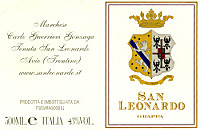
|
|
Grappa di San Leonardo |
|
| Tenuta San Leonardo (Trentino, Italy) | |
| (Distiller: Distilleria Franceschini) | |
 Pomace of Merlot, Cabernet Sauvignon and Cabernet Franc Pomace of Merlot, Cabernet Sauvignon and Cabernet Franc | |
| Price: € 30.00 - 500ml | Score: |
 Limpid, colorless and crystalline. Limpid, colorless and crystalline. Intense, clean, pleasing, refined and elegant with aromas of black
cherry, raspberry, plum, black currant, hazelnut and hay, with almost
imperceptible alcohol pungency. Intense, clean, pleasing, refined and elegant with aromas of black
cherry, raspberry, plum, black currant, hazelnut and hay, with almost
imperceptible alcohol pungency.
 Intense flavors and perceptible alcohol pungency which tends to
dissolve rapidly, good correspondence to the nose, pleasing roundness,
balanced sweetness. Intense flavors and perceptible alcohol pungency which tends to
dissolve rapidly, good correspondence to the nose, pleasing roundness,
balanced sweetness.
 Persistent finish with flavors of black cherry, raspberry, black
currant and hazelnut. Persistent finish with flavors of black cherry, raspberry, black
currant and hazelnut.
 Distilled in steam operated batch alembic still. Distilled in steam operated batch alembic still. |
|
Wine Parade |
|
|
| The best 15 wines according to DiWineTaste's readers. To express your best three wines send us an E-mail or fill in the form available at our WEB site. |
| Rank | Wine, Producer | |
|---|---|---|
| 1 |
| Villa Gresti 2006, Tenuta San Leonardo |
| 2 |
| Sagrantino di Montefalco Collepiano 2007, Arnaldo Caprai |
| 3 |
| Amarone della Valpolicella Classico Capitel Monte Olmi 2007, Tedeschi |
| 4 |
| Brunello di Montalcino Vigna Loreto 2007, Mastrojanni |
| 5 |
| Pelago 2009, Umani Ronchi |
| 6 |
| Maximo 2010, Umani Ronchi |
| 7 |
| Langhe Riesling Herzu 2011, Ettore Germano |
| 8 |
| Collio Ribolla Gialla L'Adelchi 2012, Venica |
| 9 |
| Brunello di Montalcino 2007, Donatella Cinelli Colombini |
| 10 |
| I Sodi di San Niccolò 2008, Castellare di Castellina |
| 11 |
| Verdicchio dei Castelli di Jesi Classico Superiore Podium 2010, Garofoli |
| 12 |
| Adarmando 2011, Tabarrini |
| 13 |
| Montiano 2011, Falesco |
| 14 |
| Camartina 2008, Querciabella |
| 15 |
| San Leonardo 2006, Tenuta San Leonardo |
| |||||||
Privacy Policy | |||||||


| Copyright © 2002-2024 Antonello Biancalana, DiWineTaste - All rights reserved |
| All rights reserved under international copyright conventions. No part of this publication and of this WEB site may be
reproduced or utilized in any form or by any means, electronic or mechanical, without permission in writing from DiWineTaste. |